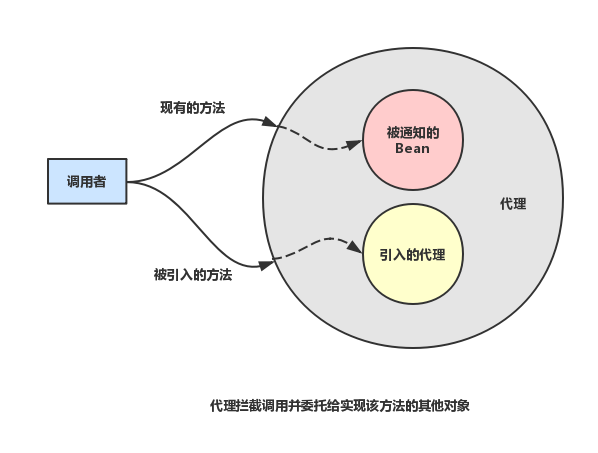AOP
AOP,面向切面编程,将系统公共服务(例如,日志记录、事务管理、缓存、性能监测等)从核心业务逻辑中剥离出封装成独立的模块(切面)。
AOP的具体实现由两种:编译期静态织入和运行期动态代理。
AspectJ 是一个基于 Java 语言的 AOP 框架,提供了强大的 AOP 功能,其他很多 AOP 框架都借鉴或采纳其中的一些思想。
AspectJ是通过特殊命令在编译时对目标类进行增强。
与 AspectJ 相同的是,Spring AOP 同样需要对目标类进行增强,也就是生成新的 AOP 代理类;与 AspectJ 不同的是,Spring AOP 无需使用任何特殊命令对 Java 源代码进行编译,它采用运行时动态地、在内存中临时生成“代理类”的方式来生成 AOP 代理。
Spring AOP
Spring AOP的原理:通过动态代理生成代理对象,代理对象的方法则通过在目标对象的切入点动态织入增强处理,从而完成对目标方法的增强。
Spring 允许使用 AspectJ Annotation 用于定义切面(Aspect)、切入点(Pointcut)和增强处理(Advice),Spring 框架则可识别并根据这些 Annotation 来生成 AOP 代理。Spring 只是使用了和 AspectJ 5一样的注解,但并没有使用 AspectJ 的编译器或者织入器(Weaver),底层依然使用的是 Spring AOP,依然是在运行时动态生成 AOP 代理,并不依赖于 AspectJ 的编译器或者织入器。
Spring中启用对 @AspectJ配置的支持
需要在Spring XML配置文件中添加<aop:aspectj-autoproxy/>或者在Spring的JavaConfig中的配置类上使用@EnableAspectJAutoProxy注解启用自动代理功能。
启动对 @AspectJ 的支持后,可以给Bean添加@Aspect注解,Spring会自动识别该Bean并将其作为切面(Aspect)处理。
当某个Bean被
@Aspect注解后,Spring容器不会再对该Bean进行增强。
Spring AOP 框架对 AOP 代理类的处理原则是:如果目标对象的实现类实现了接口,Spring AOP 将会采用 JDK 动态代理来生成 AOP 代理类;如果目标对象的实现类没有实现接口,Spring AOP 将会采用 CGLIB 来生成 AOP 代理类——不过这个选择过程对开发者完全透明、开发者也无需关心。
相关:Java动态代理
通知
1.传统Spring AOP通知接口
| 通知 | 接口 | 描述 |
|---|---|---|
| 前置通知 | MethodBeforeAdvice | 目标方法执行前实施增强 |
| 后置通知 | AfterReturningAdvice | 目标方法执行后实施增强 |
| 环绕通知 | MethodInterceptor | 目标方法执行前后实施增强 |
| 异常抛出通知 | ThrowsAdvice | 目前方法抛出异常后实施增强 |
| 引入通知 | IntroductionInterceptor | 在目标类中添加新的方法和属性 |
2.AspectJ AOP注解
| 通知 | 接口 | 描述 |
|---|---|---|
| 前置通知 | @Before | 相当于 BeforeAdvice |
| 后置通知 | @AfterReturning | 相当于 AfterReturningAdvice |
| 环绕通知 | @Around | 相当于 MethodInterceptor |
| 异常抛出通知 | @AfterThrowing | 相当于 ThrowAdvice |
| 引入通知 | @DeclareParents | 相当于 IntroductionInterceptor |
| 最终通知 | @After | 不管是否异常,通知都会执行 |
引入通知

通过引入通知来增强被通知的bean,看起来像是增加了新功能。
配置切面
XML配置
传统Spring AOP
123<aop:config><aop:advisor advice-ref=".." point-ref=".."></aop:config>定义Spring传统的AOP切面,只支持一个pointcut和一个advice,并且该advice必须实现相应的通知接口。
AspectJ AOP
1234567<aop:config><aop:aspect ref="aspect1"><aop:pointcut id="pointcut1" expression="execution(...)"/><aop:before method=".." pointcut-ref="pointcut1"/><aop:after-returning method=".." pointcut-ref="pointcut1" returning="rtval"/></aop:aspect></aop:config>定义AspectJ切面的,可以包含多个pointcut和advice,并且advice不需要实现相应的Advice接口,只需要指明对应的方法名。
注解配置
|
|
|
|
|
|